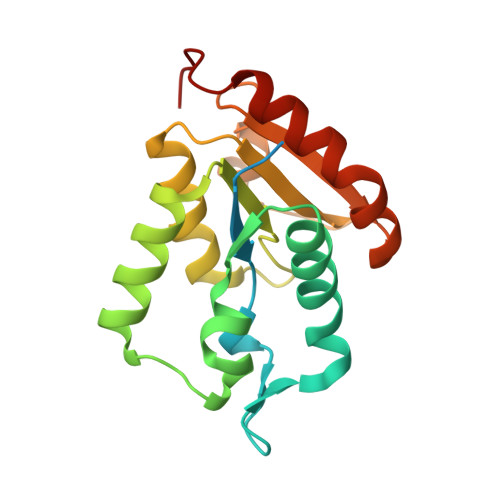Structure of the N-glycosidase MilB in complex with hydroxymethyl CMP reveals its Arg23 specifically recognizes the substrate and controls its entry
Zhao, G., Wu, G., Zhang, Y., Liu, G., Han, T., Deng, Z., He, X.(2014) Nucleic Acids Res 42: 8115-8124
- PubMed: 24920828
- DOI: https://doi.org/10.1093/nar/gku486
- Primary Citation of Related Structures:
4OHB, 4OHR - PubMed Abstract:
5-Hydroxymethylcytosine (5hmC) is present in T-even phage and mammalian DNA as well as some nucleoside antibiotics, including mildiomycin and bacimethrin, during whose synthesis 5hmC is produced by the hydrolysis of 5-hydroxymethyl cytidine 5'-monophosphate (hmCMP) by an N-glycosidase MilB. Recently, the MilB-CMP complex structure revealed its substrate specificity for CMP over dCMP. However, hmCMP instead of CMP is the preferred substrate for MilB as supported by that its KM for CMP is ∼27-fold higher than that for hmCMP. Here, we determined the crystal structures of MilB and its catalytically inactive E103A mutant in complex with hmCMP. In the structure of the complex, Phe22 and Arg23 are positioned in a cage-like active site resembling the binding pocket for the flipped 5-methylcytosine (5mC) in eukaryotic 5mC-binding proteins. Van der Waals interaction between the benzene ring of Phe22 and the pyrimidine ring of hmCMP stabilizes its binding. Remarkably, upon hmCMP binding, the guanidinium group of Arg23 was bent ∼65° toward hmCMP to recognize its 5-hydroxymethyl group, inducing semi-closure of the cage-like pocket. Mutagenesis studies of Arg23 and bioinformatics analysis demonstrate that the positively charged Arg/Lys at this site is critical for the specific recognition of the 5-hydroxymethyl group of hmCMP.
Organizational Affiliation:
State Key Laboratory of Microbial Metabolism and School of Life Sciences and Biotechnology, Shanghai Jiao Tong University, 1954 Huashan Road, Shanghai 200030, China.














